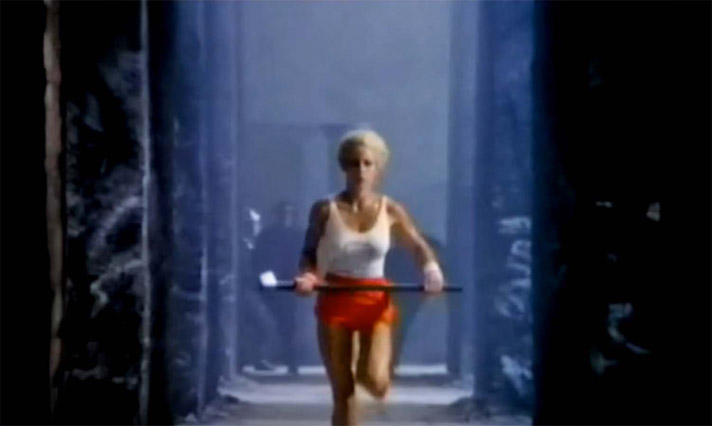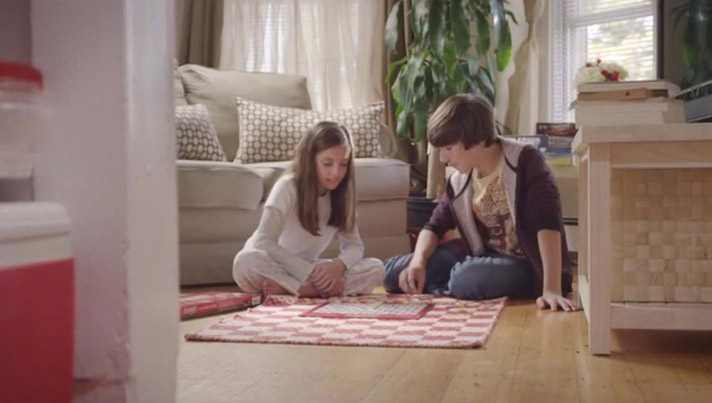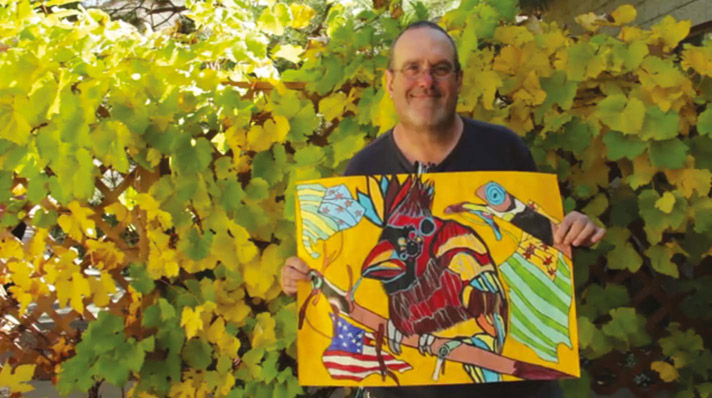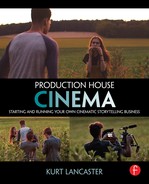Growing up watching reruns of Star Trek in the 1970s and television throughout the 1980s, I would mute commercials as a habit. They grated against my senses and I felt less intelligent by being exposed to such work. In fact, when I started directing theater, making short documentaries and short fiction work, and teaching filmmaking, I never wanted anything to do with commercials, or promotional films—nothing to do with business or work for clients. I didn’t even want to teach it to my students.
There’s a certain style to a lot of commercial work that’s far from cinematic. Messages hitting you over the head with a buy, buy, buy mentality that’s as far from cinema and art as anything I’ve ever experienced. Occasionally, there are exceptions, of course. One of the most famous cinematic commercials aired during the 1984 Super Bowl—filmmaker Ridley Scott’s Apple Macintosh ad (see https://www.youtube.com/watch?v=8UZV7PDt8Lw).

Figure 0.1 Apple’s 1984 Super Bowl commercial became a benchmark for cinematic— style commercial work. Directed by Ridley Scott. (Courtesy of Scott Free Films.)
This is a commercial for a product, but was created in a cinematically powerful way. Scott and his team consciously constructed a commercial on a grand scale and it was designed to pull you in through a mini-story using the elements of visual shots, sound design, and editing rhythm—and it defined the Apple brand in the process. It doesn’t hit you over the head with a message to sell you something—the stuff that drove me to mute commercials as a kid. Indeed, in a Forbes interview, William Gelner, executive creative director at the advertising agency 180 LA, says that the 1984 Apple ad created more buzz than any other commercial in the history of the medium. “What I personally love most, though, is that it did all this without relying on kids, talking animals, a kick in the balls or any of the other conventions we’ve come to expect from this genre.”1
Obviously, Super Bowl commercials have big budgets, so production companies can spend the time needed to make large-scale, Hollywood-style projects. Even though such examples were interesting, it wasn’t enough to get me to teach or produce such work. In the back of my mind, I wished that all commercials were as cool as Ridley Scott’s. I would continue to avoid watching or muting local commercials from car dealers, drug companies, and grocery stores, believing that the producers of such stuff continued to do their thing in a certain way, because either they never believed in the Ridley Scott cinematic vision or they didn’t have the budget to make it happen.
But then two things happened over a period of several years while teaching at my current school, Northern Arizona University:
- I was blown away by a promotional piece about a café for troubled youth in San Francisco by a Canadian production company called Stillmotion. I read their blogs, screened some of their videos and tutorials to my students— and started applying their techniques to short documentary work.
- One of my students, Jay Butler, recommended that I direct a promotional video for University Marketing at NAU. But there was only one way I would do it. Sandra Kowolski, the director of the department, wanted an approach to the creation of videos that was “different” from what she was used to getting (what might be called a staid corporate video style). I had just written DSLR Cinema and told her my desire to apply cinematic storytelling techniques to promotional videos may just be the look she wanted. She agreed, and some of the work would go on to win awards.
These two moments coalesced and I started teaching and accepting client-based work using cinematic techniques combined with storytelling.
I had originally conceived of writing a sequel to DSLR Cinema, but after talking with my publisher, I pitched them a different book. Our video/film program at NAU, Creative Media and Film, had recently gone through a curriculum re-envisioning.2 We shaped the major to not only include filmmaking, documentary, and media studies, but also a client-based class, where students learn how to not only shoot in a cinematic way, but also how to write pitches, proposals, budgets, treatments, and work directly with local clients. Realizing that this style can be taught, there was room in the market for a book that focused on the cinematic style applied to client-based work. I wanted to write a book that would explore the entire process of creating and running a production house business (one of our capstone classes is called Production House Experience) in order to give students and would-be professionals who are just beginning their career a source for knowledge and inspiration about how to start their own production house company.
But this book is not really a how-to manual. It pulls together the experiences of a couple of successful start-ups and explores how they created their businesses and approach their work. This book is about the process by which a production house gets made—from the initial vision, to the legal paperwork, to the ways you get and interact with clients, including the preproduction and production planning and processes that create the final short client-based films.
On another note, some may be disappointed that I haven’t included other cinematic-style production houses. There are hundreds. I could have made the choice to provide an overview of a dozen of these different companies or go deeply into one or two. I chose to go deep rather than broad, in order to provide more detail to the reader. I feel that in the details is where deep learning begins.
Having interviewed members of the Stillmotion team, who are now based in Portland, Oregon, as well as using some of their tutorials and storytelling models in the classroom over the past several years, I feel they’re a good choice for this book. They started their company shooting weddings while at university, and due to their application and development of their cinematic style and storytelling methods, they went from a simple event filmmaking company (like many others) to catching the attention of the NFL in one of their wedding videos. They would go on to earn multiple Emmy Awards for their endeavors. Not bad for never studying filmmaking at university! For that reason alone, I was intrigued by their process. At the same time, they consciously shared their approach to other filmmakers (I still use their tutorial on shooting with a monopod), giving back to their community of students and filmmakers trying to discover their visual style and storytelling magic. They’re one of the key players in understanding the cinematic process in video production houses.
I also include Zandrak Productions, a production house in Boston, because it’s a fresh startup, with its members just a couple years out of university.3 On the surface, that doesn’t sound like anything special and I wouldn’t be convinced necessarily, since there are so many more established production houses doing cinematic work. Why focus on a few guys from Boston? I’d never even heard of them, until I read an interview with Charles Frank on the community section of filmandmusic.com, one of the best locations for finding inspiring stories about up-and-coming as well as established indie filmmakers (https://filmandmusic.com/).4 The interview with this nineteen-year-old was insightful and I read how he works for a company called Zandrak. I went to their site and saw a project they did for Hasbro, which told the story of a father writing a letter to his son as he is about to go off to college. It touches on the themes of birth, growth, connection, and family as it shows visuals of the son playing Hasbro games as a child, interacting with his sister and family, and growing up (see https://vimeo.com/79679870).
This commercial was made on a shoe-string budget in the apartment of Zandrak’s founder, and the baby was brought in from a friend of a friend. It was directed by Charles Frank who turned down an acceptance to NYU’s film school in order to work for Zandrak. The founder of Zandrak, Andrew Hutcheson, is just a couple of years out of film school at Emerson College. These guys didn’t apprentice with commercial producers. They know film and apply those techniques to commercial work. Their Hasbro commercial is selling a product, of course, but it doesn’t tell you to buy the product. It pulls you in emotionally through the characters and the universal themes revolving around life experiences. Hasbro loved it and had the commercial broadcast nationally. It’s a commercial that I would never mute. (See Figure 0.2.)
I went to their offices in Boston and talked to them, and became convinced that not only do they have the talent to make strong client-based work, but what they have to share is invaluable to those thinking about starting their own video production business. They, like Stillmotion, belong in this book.

Figure 0.2 A scene from Zandrak’s Hasbro commercial. (Courtesy of Zandrak.)
At the same time, the cinematic style used by Stillmotion and Zandrak can be easily taught and the ideas are easily accessible. Taking the universal tools of cinema, students—as well as professionals who are used to doing client-based work in a corporate video way—can take ideas and inspiration from Stillmotion’s MUSE storytelling process, as well as from Zandrak (among others) and begin to create strong work that expresses depth and meaning. For example, a team from my senior capstone class created a promotional film for a local nonprofit, the Hozhoni Foundation, a place where people with developmental disabilities can create art and find respect (see https://vimeo.com/109904066). These students have studied filmmaking and video production over the course of nearly four years and they’re presumably on the verge of graduating and entering the professional world, at least at an entry level. For that class project, this team was inspired by some of the work done by Zandrak and Stillmotion. They created a short film that engaged a cinematic style and told a story about dignity (see Figure 0.3). Is it perfect? No, but it’s got more heart than much of the stuff I’ve muted on television for years—certainly stronger than most of the local productions I’ve seen in the preshow advertising at Flagstaff’s Harkin’s Theaters. The students (Justin Castaneda, Lori James, and Chris Navarro) earned an award at the Broadcast Education Association’s Festival of Media Arts (2015) in Las Vegas.
The filmmakers I interviewed at Stillmotion and Zandrak provide inspiration. They express a vision and energy that I like. Much of the approach to this book is through storytelling, using interviews from Patrick and Amina Moreau of Stillmotion and from Andrew Hutcheson and Charles Frank of Zandrak, among others. By using their stories, I hope to move beyond the cut-and-dry style of some texts that provide just the nuts and bolts of running a business or shooting a scene in a certain way. Focusing on their stories, their particular projects stemming from startup case-studies, I hope that readers will use them as learning tools in order to find new ways to tell stronger, more compelling client-based stories in a cinematic style.

Figure 0.3 A student at the Hozhoni Foundation presents his work of art. (Courtesy of Castaneda, James, and Navarro.)
Fundamentally, I want readers to learn how to make emotional connections to clients so that they tell stories rather than simply sell products, services, or provide messages. I want the production house filmmaker to uncover ways to conduct compelling interviews, to discover how to put together a visual treatment that makes clients take notice, to stage scenes and shoot them in a way where every shot, every cut, and the sound design makes the difference between a client receiving a project that’s like everything else out there or getting a project that’s so unique an audience leans forward, emotionally connecting with the piece.
Chapter Outline
The first part of the book, Creating Your Own Independent Video Production House Business, comprises the first four chapters in which I examine the process of setting a vision, going into the legal paperwork, and envisioning a website and portfolio sample.
In Chapter 1, Telling versus Showing: The Tools of Cinema in Client-based Storytelling, I examine in detail some of the key techniques of the cinematic style and how they can be applied to a variety of work. I examine how to use the tools of cinema to create compelling edits for pacing and rhythm by looking at a promotional film for Canon by Tyler Stableford. This cinematic style is contrasted with a narration style to storytelling used in broadcast news.
In Chapter 2, Creating a Vision: The Cinematic-Style Video Production House, I examine how Stillmotion began as a startup wedding business while Patrick and Amina were at university studying psychology. Through them, I explore what it means to create a vision and mission statement for your business.
Chapter 3, Making it Legal: Filing an LLC, Writing Contracts, Music Rights, and Getting Insurance, is perhaps one of the most important chapters of this book, providing the tools needed to make your business legal and to protect it. It lays out the steps to creating a limited liability company, provides sample contracts from Zandrak, explains how to create an invoice through online applications, get an insurance quote online, and how to write off business expenses so you’ll pay less taxes.
Chapter 4, Creating Presence: The Portfolio Reel and Website that Reflects Your Style and Vision, examines in-depth the website of Stillmotion, while also looking at sample portfolio films from both Stillmotion and Zandrak. By using these examples, you can generate ideas in how you might approach your website and portfolio work. It doesn’t tell you how to design a website or portfolio film, but it discusses why these particular websites and portfolio pieces are so compelling so you can use them as role models.
In the second part of the book (Chapters 5–7) we cover the different tools for Running an Independent Production House Business, which covers the ideas of working with clients and developing pitches and proposals. In addition, I examine some of the gear needed and what you should be looking for when buying or renting gear.
Chapter 5, Making Money: The Cost of Doing Business, Generating Income Streams, Setting Up Invoices, and Planning Your Taxes, includes a process by which you can figure out how much you need to make in order to run your business successfully. It also includes an overview of how to work out your personal as well as your business budget. This chapter also considers different ways to generate income, submitting invoices, and planning for your taxes— some of the bigger-picture things that revolve around the daily operations of your business.
Chapter 6, Developing a Client’s Story: Making a Connection, Finding the Story, and Writing a Pitch, Proposal, and Budget, examines Stillmotion’s approach to treating clients and making a connection with them. This is one of the key elements of this book, since if you can’t do this you won’t be in business long. It also provides a detailed example of a visual pitch proposal for Zandrak’s Moodsnap.
In Chapter 7, Cinematic Gear on a Budget: What You Need and What it Does, I look at the some of the equipment you need to start shooting at a professional level utilizing cameras under $5,000, wireless lav mics, shotgun mics, monopods, tripods, sliders, and jibs, among other useful equipment. But the majority of the chapter is dedicated to understanding what you’re looking for in a computer, camera, and other types of gear. If your camera records in 8-bit H.264 codec (nearly every DSLR and lower-end cameras do), then you should know why this is not a good thing and how to overcome that limitation. It explores such concepts as: What is the difference between rolling shutter and global shutter? What’s the deal, 4K or raw? What’s the difference between shutter speed and shutter angle and what does it do? These types of questions will be explored as we delve into the guts of cameras and audio gear so you will understand what you should look for, rather than just shooting with something because it’s popular. The knowledge from this chapter can be applied to nearly any camera you get, so even if a camera isn’t mentioned or listed, you’ll be able to read the specs to see if it is something you will want to use.
In the final section of the book, Crafting the Cinematic Style, I go into details with case studies of cinematic-style client-based projects from Stillmotion and Zandrak. Lastly, I examine the process in crowd-funding your own personal projects, using Alexandria Bombach’s successful campaign for her documentary, Frame by Frame.
In Chapter 8, A Book Promotion Case Study: From Keywords to Storyboards in Stillmotion’s “My Utopia,” I explore Stillmotion’s creative process in developing keywords and applying them to a production based on Stephanie Henry’s nonfiction book about her past abuse. Rather than following conventional documentary style, Stillmotion created a narrative short based on Stephanie’s high-school essay about how she faced abuse. The chapter includes their notes on character, keywords, and some of the storyboards developed for the opening sequence of their film.
In Chapter 9, An App Promotion Case Study: Directing with Spontaneity in Zandrak’s “Our Songs,” I include extensive interviews with Charles Frank, the director of the Moodsnap app, exploring how he made creative decisions in shaping the narrative thrust of this short.
Chapter 10, A Crowdfunding Case Study: Financing Frame by Frame, explores crowdfunding techniques and the unique ways a couple of different companies situate themselves, including Seed&Spark and Kickstarter. I provide a case study of Alexandria Bombach, a young woman who graduated from college in 2008— at the birth of the great recession—and sold everything she had to start making films and working with clients. It explores how she used Kickstarter to fund a feature documentary about four Afghan photojournalists working in the post-Taliban reconstruction. It is now on the festival circuit and received a glowing review from The Hollywood Reporter. She raised $70,000 from Kickstarter, which funded the project. It examines the campaign in detail, providing pointers on how you can use crowdfunding to fund your personal projects.
Purpose of this Book
Ultimately, I want to show that when the tools of cinema are used properly, they help create something magical. Even as I write this in July 2015 while visiting relatives in Wolfeborrow, New Hampshire I see a story on CNN break to commercial—my automatic reflex is to mute it, but it’s too compelling as I watch beautiful shots unfold, taking me on a journey about a man and his dog—it’s a Subaru commercial told in a cinematic style.5 The next commercial blares out in a standard “smack you in the face” style, attempting to convince me that they’re a great insurance company and I’m groping for the mute button. The differences are stark. The Subaru commercial is simply more powerful and a pleasure to watch; the other one not so much.
There are plenty of cinematic-style commercials being made—more so than at any other time. For example, The Herd Films in Vancouver reveal their storytelling filmmaking talent in their 2014 commercial for Chevrolet, “Maddie.” It tells the story of a woman and her elderly dog. As the commercial progresses, we see the woman and the dog in key moments from their lives going back in time linearly—to the point where the woman as a girl picks out Maddie, her dog, from a litter of puppies.6 The commercial spot, directed by The Herd Films’ Lloyd Lee Choi, tells a story with emotional depth in 70 seconds. It doesn’t feel like a commercial. It feels magical. Cinema should be magical and when filmmakers apply techniques of cinema to commercials and promotional projects—you get what I call production house cinema, creating moments of cinematic magic through visuals shaped by strong cinematography, every shot beautifully lit, with a sound design that’s compelling, and an editing flow with rhythm.

Figure 0.4 Maddie looks at her owner in the Chevrolet commercial, “Maddie,” about the life process of aging and living moments. Directed by Lloyd Lee Choi from The Herd Films of Vancouver, Canada. (Courtesy of The Herd Films.)
The intent of this book is to convince client-based producers to use different facets of the cinematic style so that we get more commercials and promotional projects that feel and look like small pieces of cinema. It is my hope that this book will inspire a new generation of film students and filmmakers who want to work with clients to create compelling story-based commercials, promotional films, and multimedia journalism, among other types of cinema-based projects.
In many ways, I want filmmakers creating client-based work to think about what Ursula K. Le Guin says about the nature of aging and the memories of youth as she writes about her mother’s passing:
I see a little red-haired child in the mountains of Colorado, a sad-faced, delicate college girl, a kind, smiling young mother, a brilliantly intellectual woman, a peerless flirt, a serious artist, a splendid cook— I see her rocking, weeding, writing, laughing—I see the turquoise bracelets on her delicate, freckled arm—I see, for a moment, all that at once, I glimpse what no mirror can reflect, the spirit flashing out across the years, beautiful.
That must be what the great artists see and paint. That must be why the tired, aged faces in Rembrandt’s portraits give us such delight: They show us beauty not skin-deep but life-deep.7
If anything, the best of cinema tries to capture people’s life-deep moments. It takes a conscious use of cinematography, storytelling, and an understanding of humanity to capture such fleeting essences, and if you can begin to capture such moments through your personal work and for your clients, then you’ve done your job—you’ve created something authentic that will likely move an audience.
